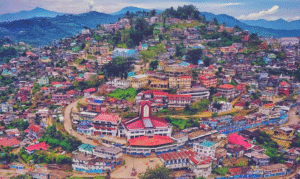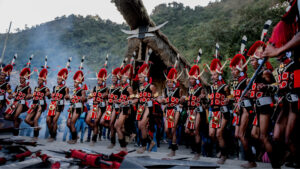Mizoram is called the “Land of the Hill People.” It is a cherished state in northeast India. Phawngpui lies on the state’s southeast border, overlooking a bend in the huge Chhimtuipui River and the Myanmar hill ranges.
The name “Blue Mountain” is justified as a thin layer of cloud covering the hills, throughout the year. It is Mizoram’s highest mountain summit, rising to 2157 meters. It is located in Lawngtlai District. Mizoram’s Lai dialect translates Phawngpui as a great meadow. Phong translates into ‘meadow’ and pui means ‘great.’
Lifestyle
Life in Phawngpui is a harmonious blend of tradition and modernity. The Mizo people are hospitable and warm. They believe in living a life filled with laughter and joy. They have called these hills home for centuries.
Their stilted houses called “Chang Gharkhan,” are spread throughout the hilly landscape. They are made of locally found bamboo walls. They decorate them with carefully woven handloom. The locals are hardworking and resourceful. For centuries they have built a community out of self-sufficiency.
They also participate in various activities to keep up with the rhythm of life. They play the tune of “cheraw,” a bamboo lute that echoes through the valleys with soulful melodies. Evenings come alive with vibrant dances like “khuollam,” while skilled men and women weave age-old patterns. Their colorful “puanchei” or a traditional shawl is another such glory of the people residing here.
A Nature Lover’s Paradise
These hills are covered with waterfalls that flow down on moss-covered rocks. The quiet waters of Tamdil Lake, reflect the blue hills. The land also supports a home to wild animals and birds like Goral, Serrow, Barking Deer, Sambar, Leopard, Kaleej Pheasant, Hollock Gibbon, Common Langur, and Rhesus Macaque. A unique set of herbs and orchids are also found here.
A National park is created by the government to preserve the natural habitat of this area.
Rich Cultural Heritage
Phawngpui’s culture is as rich as its landscapes. The people living here are close-knit and share a close community bond. They are involved in each other’s lives and live harmoniously.
The annual Chapchar Kut is a harvest festival that witnesses the community come alive with vibrant costumes, joyous dances, and traditional songs.
The Lui Ngai Ni is a celebration of the Mizo war hero Laldenga. It resonates with stories of valour and sacrifice. These festivals are not just celebrations for the locals; they are what ties the community together.
Occupation
Life in Phawngpui is a balance between age-old traditions and modernity. They discovered a balance to preserve their heritage and cultural lifestyle. They are very resourceful and skilled their way into doing things for their survival. They don’t shy away from learning new techniques to improve their lives. However, they keep a keen eye on maintaining nature’s natural habitat.
Agriculture remains the main occupation with fertile rice fields covering the valleys. Backyards often double as vegetable patches, providing fresh and organic produce for families.
Tourism is also on the rise, opening up new opportunities. Homestays and adventure activities like ziplining, paragliding, and kayaking down the Tamdil River are being encouraged.
Skilled hands weave intricate “Puanchei” and other textiles, transforming them into vibrant souvenirs of ancestors.
Many young entrepreneurs are setting up shops and cafes catering to both locals and tourists. Carpentry workshops are also opening up from locally sourced wood. The digital world has seeped into these hills too; many are working in tech-related industries.
Cuisine
The locals enjoy a whole-hearted meal. Bai(steamed rice) is the base that is eaten with several side dishes. Chhang zawk is a pork stew simmered with chilies and ginger and is a local favorite. Vawka is made out of fermented bamboo shoots which add a tangy punch while ‘Inthar’ is a dried fish curry to give a kick to the meals. The locals serve all of it with chilli chutney. In such a place where the temperature goes down frequently, having a kick is what saves the day.
Zu is a locally brewed rice beer served in bamboo mugs. It is the local tipple of choice.
Life in Phawngpui isn’t just about work and food. Weaving is a time-honored tradition in these areas. It’s a way of life. Stories of many generations are passed on through these carefully woven patterns.
Spirituality and Folklore
The hilly top of Phawngpui has spiritual significance to the Mizo tribe. There is a common belief that the Mizo Gods reside in these hilltops.
In places such as Mizoram, the art of storytelling is what keeps their history alive. Wonders about these hills are passed on by word of mouth. Mizoram’s Phawngpui hills are seeped by nature’s wonders as well as whispered folklore. Amidst the valleys, peaks, lakes, and rivers lie mystical tales of the Mizos.
One such tale speaks of Phawngpui’s namesake, the Blue Fairy. Legend has it that she dwells in a hidden cave. She is known for her ethereal beauty which mirrors the mountains. She supposedly watches over the valley, ensuring hearty harvests and protecting the Mizo people.
Another tale speaks of the “Tremot Raja,” a mischievous spirit who haunts the Tamdil Lake. With long, flowing hair the color of the water and eyes that gleam like emeralds. He lures unsuspecting travelers into his watery domain. His laughter warns the people to not venture too close to the waters.
Phawngpui’s folklore is not just about fantastical creatures. It is also a warehouse of wisdom passed down through generations. It is how they have protected these lands. Stories of brave warriors, like Laldenga, and wise elders steered the community through times of hardship. People who fought for their land remind the Mizo people of their rich heritage and the values that bind them together into a community.
Phawngpui is more than just a stunning landscape; it’s a state of mind. The land is all about the peaceful coexistence of man with nature. It is deeply connected with a culture, steeped in tradition. It is an example of discovering a way of life that values simplicity.
Conclusion
Living a hilly life is never easy. Phawngpui too, has its own set of challenges. Transportation can be tricky, and access to certain amenities might be limited. However, the sense of community, the natural beauty, and the delicious cuisine make it a place where life unfolds at its own pace.
The lives of the people living in Phawngpui here are strengthened by a shared history and identity. Through the mystical tales and resourcefulness of the Mizos, they have survived in these holy Mizo hilltops.
Unravelling a billion untold stories, one chapter at a time, Humans of Northeast takes you on a discovery through vibrant Northeast India – a land rich in people, places, and culture. Ready to immerse yourself in more such stories? Visit our page HONEI to read more about narratives that inspire and uplift.






